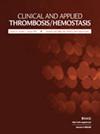剖腹产肥胖妇女的静脉血栓栓塞风险因素
IF 2
4区 医学
Q2 HEMATOLOGY
引用次数: 0
摘要
静脉血栓栓塞症(VTE)是孕产妇死亡的主要原因。肥胖和剖宫产是妊娠相关 VTE 的既定风险因素。我们在接受剖宫产的肥胖患者中发现了其他风险因素,以确定哪些患者需要进行 VTE 预防。我们采用病例对照设计对母胎医学单位网络(MFMU)剖宫产登记数据库中的数据进行了二次分析。病例被确定为孕前体重指数为 30 kg/m2 的肥胖妇女,她们接受了剖宫产,随后出现了深静脉血栓 (DVT) 或肺栓塞 (PE)。这些妇女与接受剖宫产但未发生深静脉血栓或肺栓塞的肥胖妇女对照组进行了比较。我们使用 Chi-Square 检验和费雪精确检验对与 VTE 相关的风险因素进行了分析。我们在 MFMU 数据库中发现了 43 例 VTE 病例和 172 例对照。患有子宫内膜炎(OR 为 4.58 [95% CI: 1.86-11.2, P = .0004])、接受过输血(OR 为 17.07 [95% CI: 4.46-65.3, P = .0001])、有凝血功能障碍(OR 27.73 [95% CI: 3.24-237.25, P = .0003])和尿路感染(OR 2.39 [95% CI: 1.08-5.28, P = .03])。接受剖宫产的肥胖妇女发生 VTE 的重要风险因素包括子宫内膜炎、术中或术后输血、凝血功能障碍和尿路感染。这些因素中的一个或多个可能有助于指导医疗服务提供者决定是否采取血栓预防措施。本文章由计算机程序翻译,如有差异,请以英文原文为准。
Venous Thromboembolism Risk Factors in Women With Obesity Who Undergo Cesarean Delivery
Venous thromboembolism (VTE) is a leading cause of maternal mortality. Obesity and cesarean delivery are established risk factors for pregnancy-related VTE. We identified additional risk factors among patients with obesity who underwent a cesarean delivery to identify those who need VTE prophylaxis. We conducted a secondary analysis of data from the Maternal-Fetal Medicine Units Network (MFMU) Cesarean Registry Database using a case-control design. Cases were identified as women with obesity having a pre-pregnancy body mass index of >30 kg/m2 , who underwent cesarean delivery and subsequently developed deep venous thrombosis (DVT) or pulmonary embolism (PE). These women were compared to a control group of women with obesity who underwent cesarean delivery but did not develop DVT or PE. Analysis of risk factors associated with VTE was performed using Chi-Square test and Fisher's exact test. We identified 43 VTE cases and 172 controls in the MFMU database. Increased risk of VTE was noted in women with endometritis (OR of 4.58 [95% CI: 1.86-11.2, P = .0004]), receiving a blood transfusion (OR 17.07 [95% CI: 4.46-65.3, P = .0001]), having a coagulopathy (OR 27.73 [95% CI: 3.24-237.25, P = .0003]), and urinary tract infection (OR 2.39 [95% CI: 1.08-5.28, P = .03]). Important risk factors for VTE in women with obesity who undergo cesarean delivery include endometritis, intra- or post-operative transfusion, coagulopathy, and urinary tract infection. The presence of one or more of these factors may help guide provider decision-making regarding whether to administer thromboprophylaxis.
求助全文
通过发布文献求助,成功后即可免费获取论文全文。
去求助
来源期刊
CiteScore
4.40
自引率
3.40%
发文量
150
审稿时长
2 months
期刊介绍:
CATH is a peer-reviewed bi-monthly journal that addresses the practical clinical and laboratory issues involved in managing bleeding and clotting disorders, especially those related to thrombosis, hemostasis, and vascular disorders. CATH covers clinical trials, studies on etiology, pathophysiology, diagnosis and treatment of thrombohemorrhagic disorders.

 求助内容:
求助内容: 应助结果提醒方式:
应助结果提醒方式:


